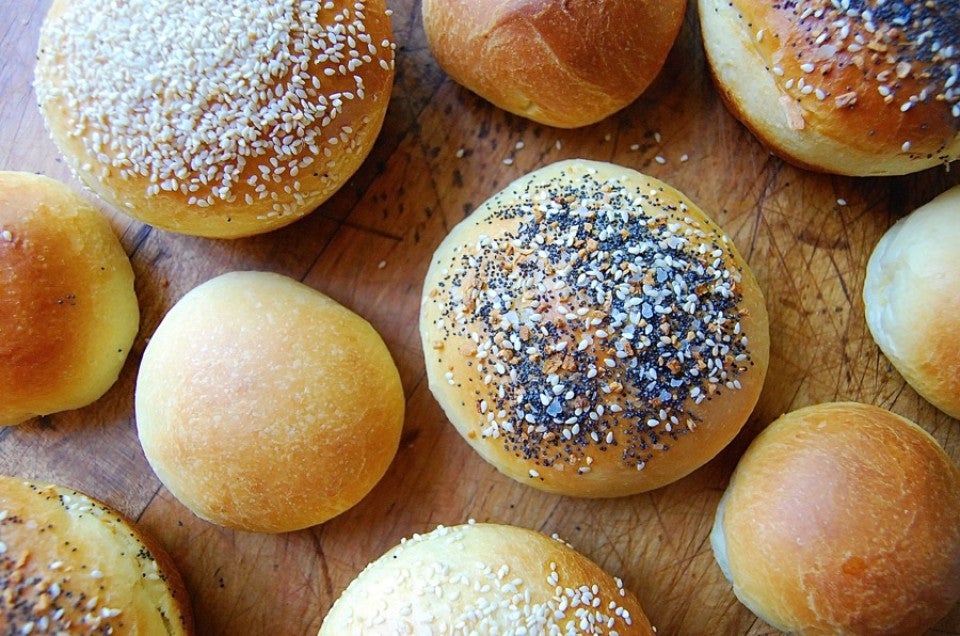


If the word brioche conjures up a mental image of an oversized, buxom loaf with a rather complicated topknot – think again. Brioche buns are the simple way to enjoy this French classic.
Here's the first thing you need to know about brioche dough: it's rich. Packed with eggs and butter, it bakes up into a light, mahogany-brown loaf perfect for sandwiches. And if you're making breakfast toast, don't bother with the butter dish; a simple slather of jam is sufficient.
Brioche buns – brioche dough, shaped into burger buns – bring their signature richness to the backyard barbecue. Tender (but not crumbly), light (but still substantial), they're absolutely perfect for a big burger and all the fixings.
But don't stop there. A juicy grilled chicken breast with sliced avocado and homemade salsa might destroy a typical store-bought bun, reducing it to soggy crumbs. But brioche buns are undeterred by excess moisture; bring on the relish!
Have you ever made a classic brioche? Then you'll enjoy this new twist on an old favorite.
Never made brioche? Follow these simple steps for a tasty take on burger buns.
Brioche dough doesn't come together quite like standard yeast dough. So pay close attention to our tips along the way.

Low-fat brioche is an oxymoron. The texture and flavor of these buns rely on butter and eggs, so bite the bullet and use the full amount of both – including the extra egg yolk. You won't be wasting the white; you'll use it later on.
Start by putting the following ingredients into a bowl; preferably the bowl of a stand mixer, though alternatively you can use an electric hand mixer. Your bread machine, set on the dough cycle, is also a good choice.
2 3/4 cups (326g) King Arthur Unbleached All-Purpose Flour
1/4 cup (28g) Baker's Special Dry Milk or nonfat dry milk
2 tablespoons (25g) sugar
1 1/4 teaspoons salt
1 tablespoon instant yeast
3 large eggs + 1 large egg yolk, white reserved for wash (below)
1/4 cup (57g) water*
10 tablespoons (142g) unsalted butter, at cool room temperature
*Start with 3 tablespoons in summer, or under humid conditions; 1/4 cup (4 tablespoons) in winter, or when it's dry out.
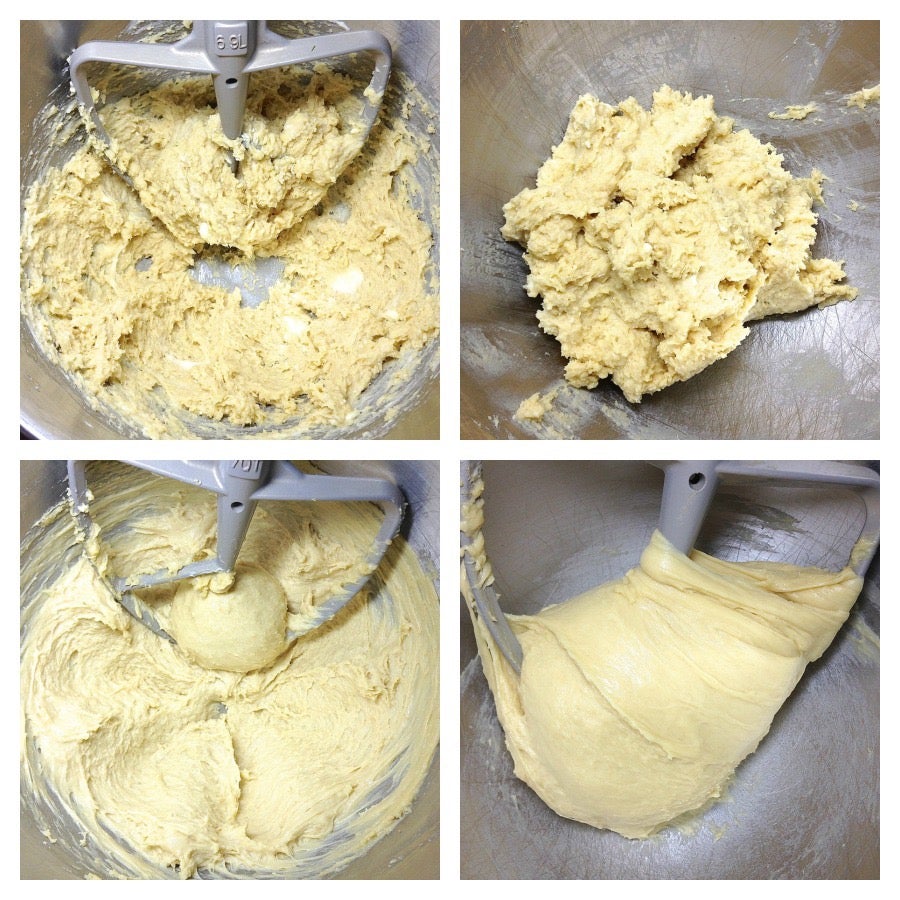
Can you mix and "knead" brioche dough by hand? I'd recommend this ONLY if you're a seasoned and very fit bread baker. Fully developing this rich dough by hand would probably take up to 25 to 30 minutes of vigorous mixing with a spoon; it's so soft that only at the very end might you be able to actually knead it.
Don't bother getting out your mixer's dough hook; you'll be sticking with the beater blade here – "sticking" being the key word. This dough is STICKY when it starts out, before eventually becoming smooth, soft, and satiny.
Start by mixing all of the ingredients together at medium speed. They'll cling to the sides of the bowl; scrape them into the center, and mix some more. I use speed 4 on my KitchenAid.
Continue mixing the dough at medium speed. After about 10 minutes or so, you should see it starting to form a ball (lower left photo). Scrape the dough into the center of the bowl again, and continue to mix, scraping the bowl to help it along, until the dough is smooth and soft, perhaps sticking a bit but no longer coating the sides of the bowl.
Attention, bread machine aficionados: set your machine on the dough cycle, and walk away. The bread machine is PERFECT for making brioche dough. When the dough cycle is complete, refrigerate it overnight (instructions below).
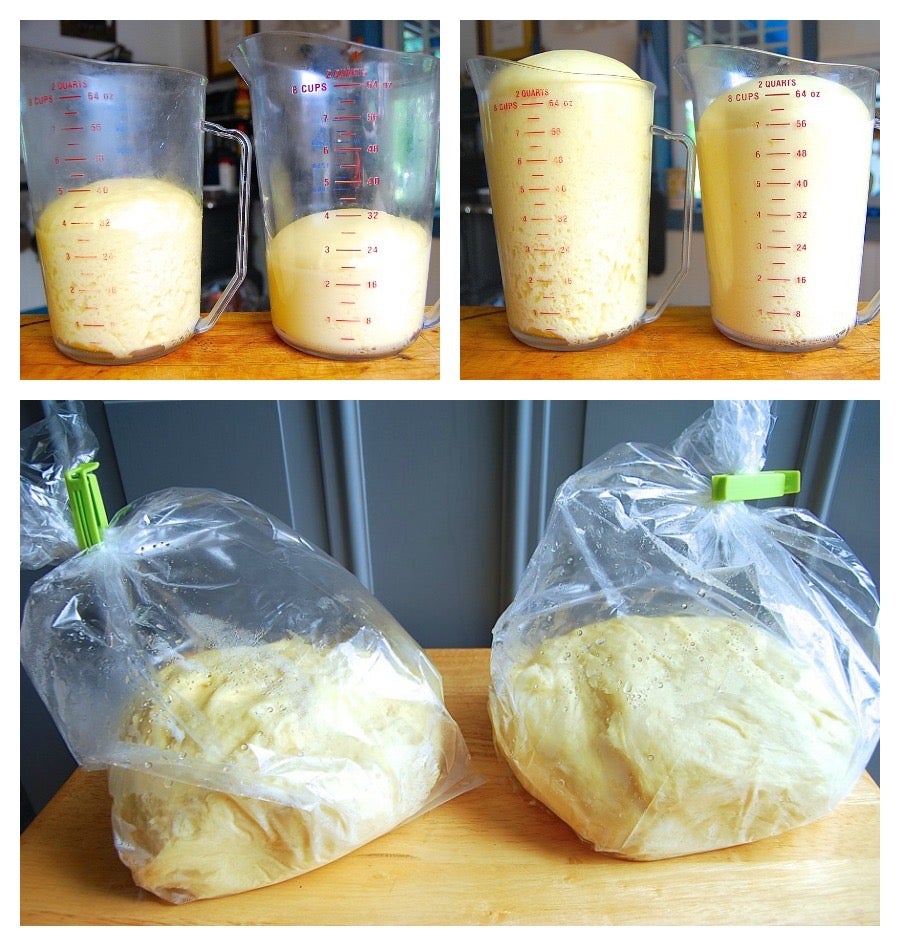
Brioche dough is easier to handle when it's cold. So let it rise at room temperature until it's noticeably puffy (top photos); then place it in a bag (no need to grease the bag), fasten the bag at the top, and refrigerate the dough overnight.
Why do I have two batches of dough going here, you ask? I was testing two yeasts: SAF Red and SAF Gold. SAF Gold helps dough with a higher percentage of sugar rise better; would it also help dough with a higher percentage of fat?
The answer is no; it works the same as SAF Red in high-fat doughs. Though SAF Red (on the left in the two photos) actually appears to work better than Gold, that's simply because it had a half-hour head start; I mixed the Red dough first, followed by the Gold.
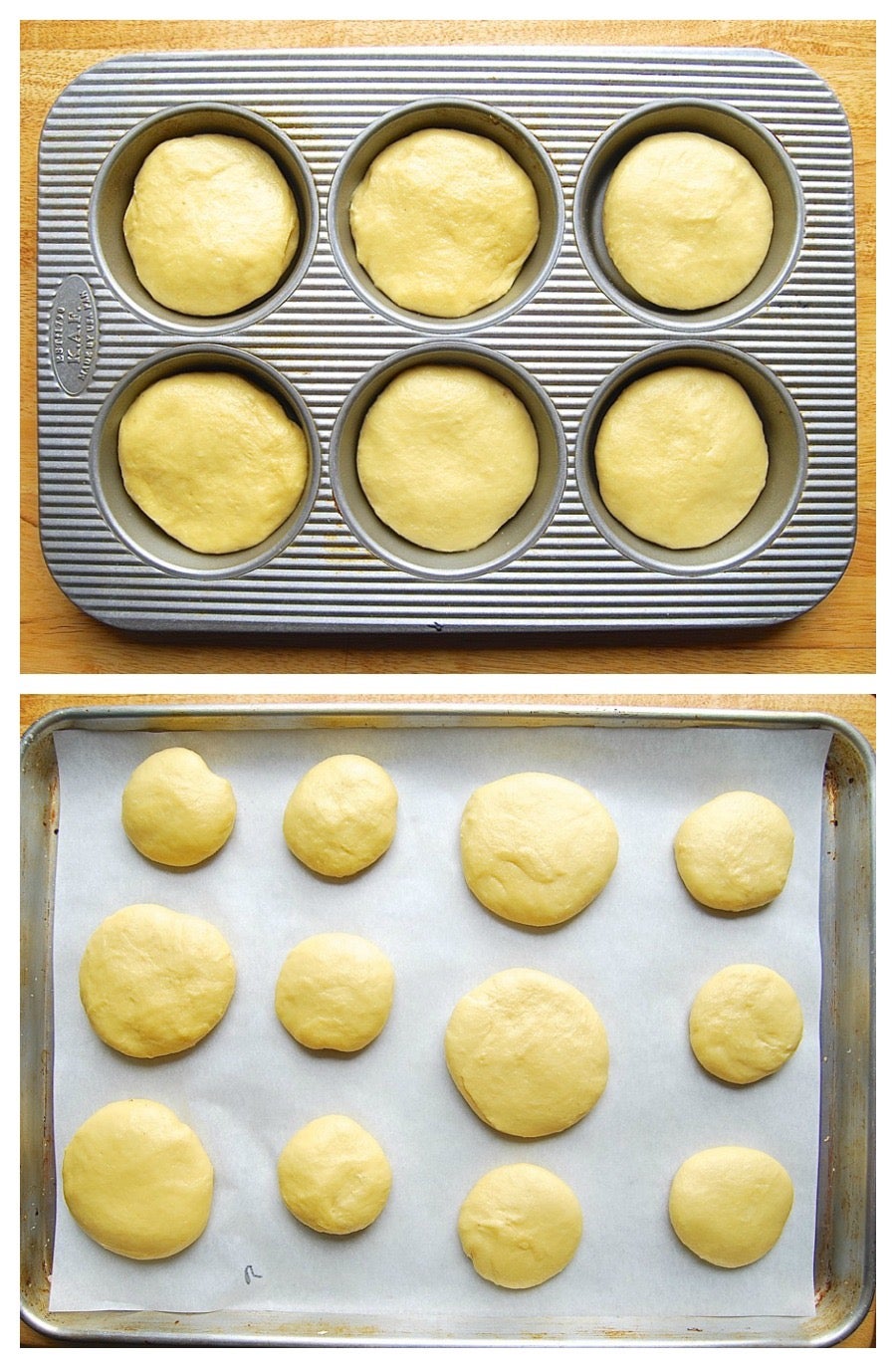
This recipe will make six mega-buns, perfect for your half-pound burgers; eight standard burger buns; or 16 mini-buns, just right for sliders.
Divide the dough into the desired number of pieces. If you have a scale, weigh the dough before you start; this will make division totally simple.
Shape each piece of dough into a flattened round: about 3 1/4" diameter for large buns, 3" for standard, and 2 1/2" for mini.
Place the larger buns in a hamburger bun pan, if desired, for extra support. Standard and mini buns will be fine on a half-sheet pan, spaced about 2" apart. I like to line the pan with parchment, for easiest cleanup.
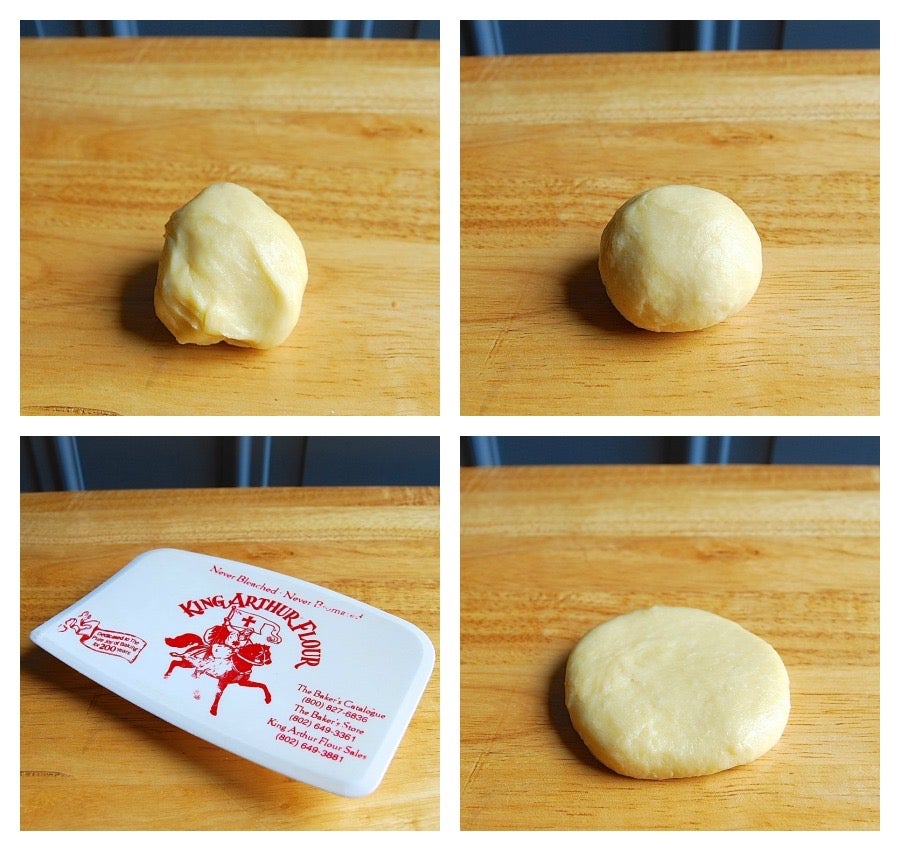
Since the dough is both chilled and high in fat, you'll find it easy to work with; it feels a bit like soft, smooth clay, rather than a typical springy yeast dough.
You can get pretty smooth brioche buns simply by using the palm of your hand to flatten them. But here's a helpful tip: once you've shaped the dough into a ball, flatten it with something completely flat: like a bowl scraper, or the bottom of a measuring cup (if you have one large enough). Press down firmly, then make a couple of small circles with your hand (think washing a window), to "round" the bun under pressure.
So, how come those buns in the previous photos don't look perfectly smooth and round? I didn't discover this technique until I was nearly done shaping them, and was discouraged with the results. Necessity is the mother of invention!
Because the dough is cold, the brioche buns may take longer to rise. Let them. Don't set your stopwatch and rail against fate if they're not nice and puffy when the alarm goes off.
If the dough is particularly cold and your house is, as well, the buns may take up to 3 hours to rise fully. On the hot summer day when I made these, they only took about 90 minutes.
And what does "rise fully" mean? Well, if you're making them in a hamburger bun pan, they should definitely crest above the rim of the pan.
For buns on a baking sheet, they should start to "lift" off the sheet: see how their sides are bulging out just a bit, starting to become the big, rounded buns they'll bake into? That's what you're after.
Towards the end of the rising time, preheat your oven to 375°F, with a rack in the center.
Remember that egg white you saved, back when you were making the dough? Whisk it with 1 tablespoon cold water, and brush the resulting "egg wash" on the buns.
Then top with seeds: sesame, for a typical fast food-type sesame seed bun; or my favorite, everything bagel topping, a tasty mixture of poppy and sesame seeds, dried onion, garlic, and salt.
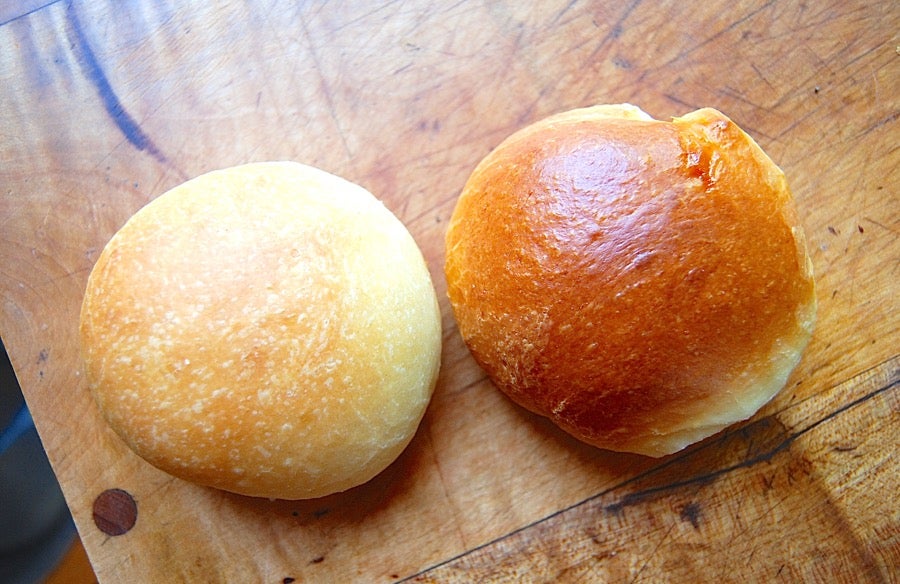
Even if you're not adding seeds, it pays to brush the brioche buns with egg wash. On the left, an "unwashed" bun; on the right, a washed bun. Egg white adds both color and shine.
Some seeded, some plain – looks like these plump brioche buns are ready.
Bake the large buns for 18 to 19 minutes. Slider buns will take about 14 minutes, and standard buns something in between. The buns should be golden brown, and a digital thermometer inserted into their center should read 190°F.
Note to those who want to mix bun sizes on the same pan, as I did. Remember, the smaller ones will bake more quickly than the larger ones. When the small ones are done, grab ’em off the baking sheet with a pair of tongs (or your baker-tough, heatproof fingers - OUCH); and transfer them to a rack to cool, leaving the larger buns in the oven to continue baking.
Now there's one caveat to all this, and it leads to our final tip –
Brioche buns will brown quickly, due to their high fat content, as well as the egg wash. And you want to err on the side of moistness. So keep your eye on the buns as they bake, and your digital thermometer handy.
No thermometer? It pays to break one open when you think they're done. If you see no sign of raw dough at the center – take ’em out of the oven, they're perfect.
Aren't you craving a burger right about now?
Please read, bake, and review our recipe for Brioche Buns.